Acid rain is a result of the atmosphere’s natural cleansing mechanism. Acid-forming chemicals are emitted into the atmosphere by vehicles and industry, and also by natural processes such as volcanic eruptions and spray from ocean waves. The chemicals remain in the atmosphere for several days, where they are carried by the winds, heated by the sun, and changed into acids by chemical reactions. Eventually rain, snow and fog removes the acids from the sky, cleaning the air but delivering harmful pollutants to the earth’s surface.
A group of scientists at the University of Mexico are researching the damage acid rain is causing to an important Mexican archaeological site: El Tajín (pronounced ‘el taheen’). This webquest is based on their work. To begin the quest, explore the links below to gain the background information necessary to understand and complete your tasks.
The El Tajín archaeological site
Located in the state of Veracruz, El Tajín (pronounced ‘el taheen’) is one of Mexico’s many important archaeological sites. Most of the site is still unexcavated. The site is filled with many mysterious and fascinating ruins. Reaching its height from the early 9th to the early 13th century, the cultural influence of Tajín was felt all along the Gulf of Mexico and into central Mexico. El Tajín has survived as an outstanding example of the grandeur and importance of the pre-Hispanic cultures of Mexico.
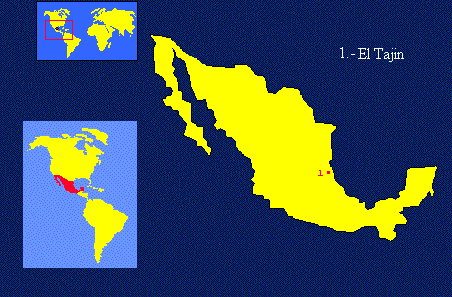 |
| Location of El Tajín. |
The Thunder God
The word “Tajín” means thunderbolt in the ancient Totonac language. “El Tajín” may therefore have been a god of thunder, lightning or hurricanes. The El Tajín archaeological site was probably a place to worship this god.
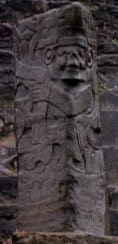 |
| Statue of El Tajín, the thunder god. |
Pyramid of the Niches
The most famous of all El Tajín buildings is the Pyramid of the Niches, a masterpiece of ancient mesoamerican architecture. This pyramid is believed to be an ancient calendar. The 365 niches, or alcoves, which used to be painted bright blue and red, probably represented the days of the year.
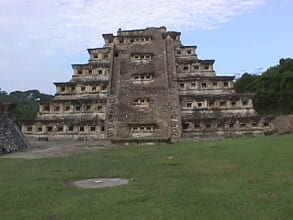 |
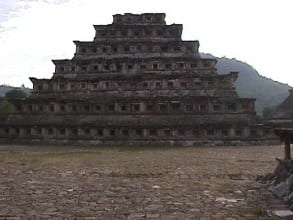 |
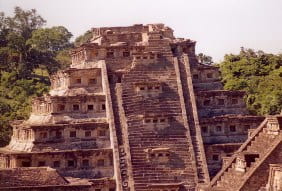 |
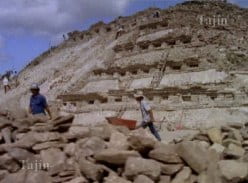 |
| Different views of the Pyramid of the Niches. The photo in the lower right corner shows the pyramid during its excavation. | |
Ballcourts
El Tajín is also famous for its remarkable ballcourts, with stone carvings depicting human sacrifice. The ballgame was a mysterious religious ceremony involving a ball propelled through hoops by knees, hips and elbows. Some archaeologists believe the winners of the game earned the honor of being sacrificed to the gods. Others believe that the losers were sacrificed as a penalty for poor performance. Still others think the ball game may have served as a training exercise for young warriors.
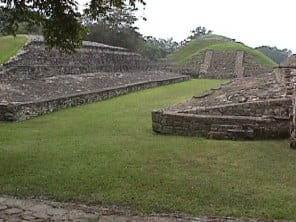 |
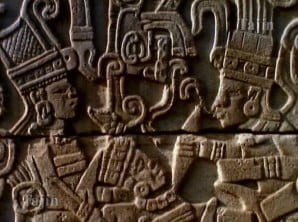 |
| Ballcourt | Stone carving depicting human sacrifice after a ballgame. |
Voladores
The Totonacs, the ancient people who lived at El Tajín, had a fascinating religious ritual called the Flight of the Voladores (volador means flyer). The flight of the Voladores is a breathtaking spectacle in which four men “fly” upside down from a 100-foot pole while a musician dances, drums, and plays a haunting melody on the flute at the top of the pole.
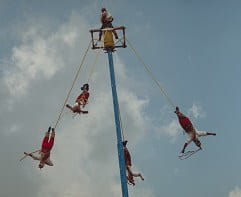 |
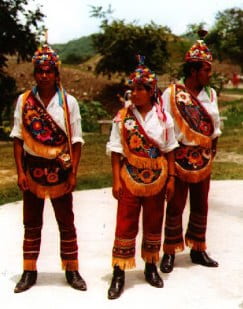 |
| Voladores in flight. | Voladores in traditional costumes. |
More information on the Voladores
- Video of the Flight of the Voladores (wmv) (mov)
- Colorful description of the Flight of the Voladores
- History of the Voladores